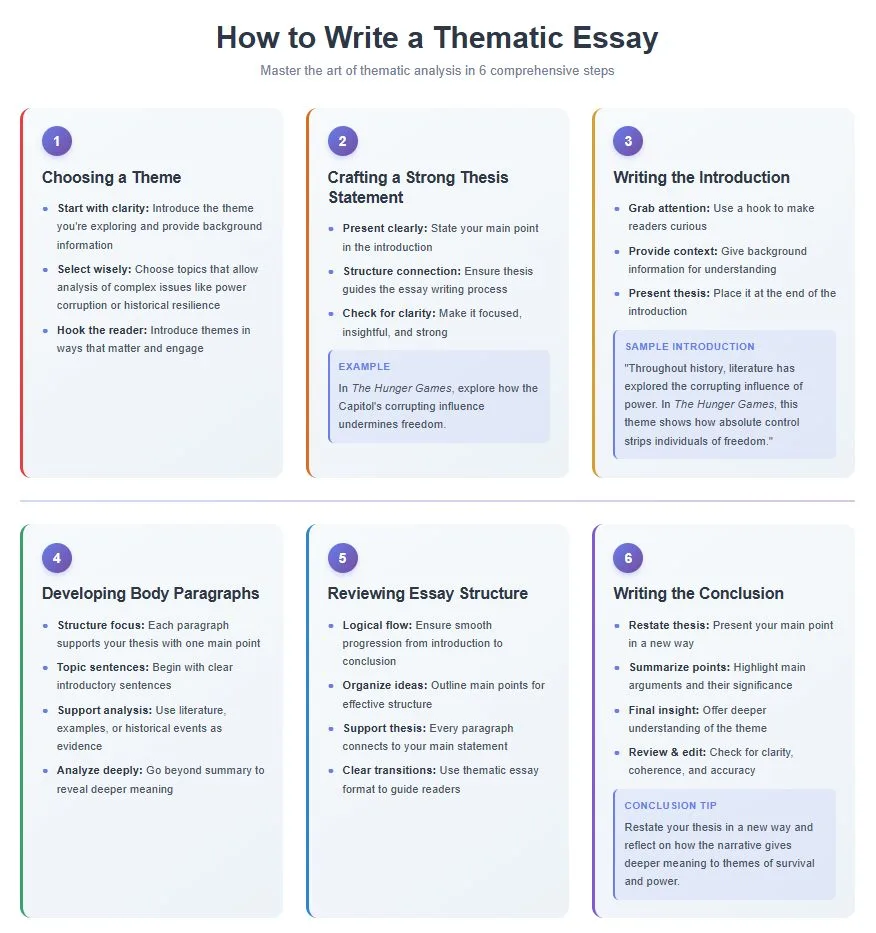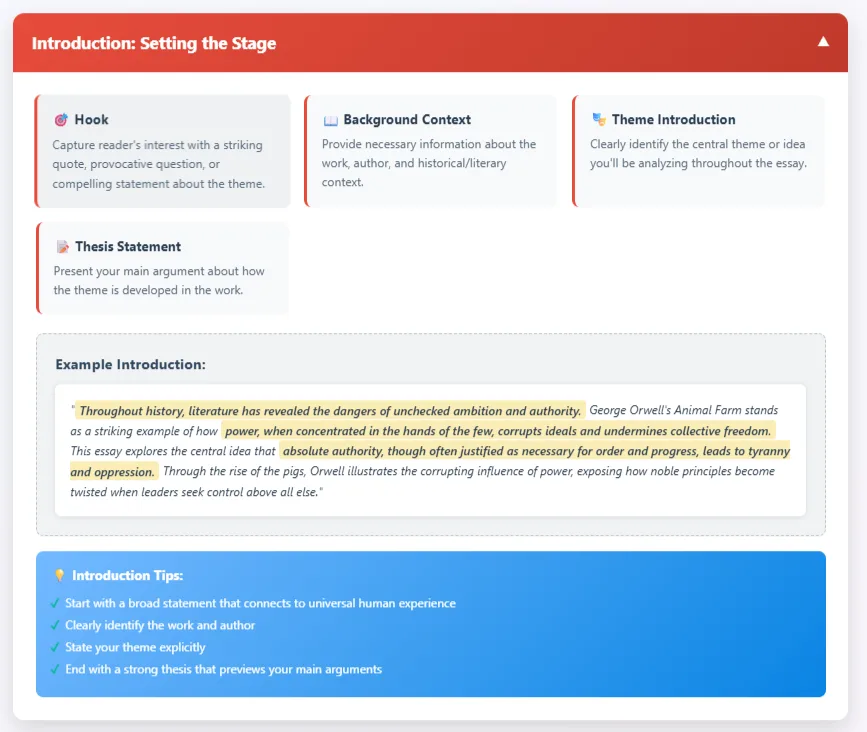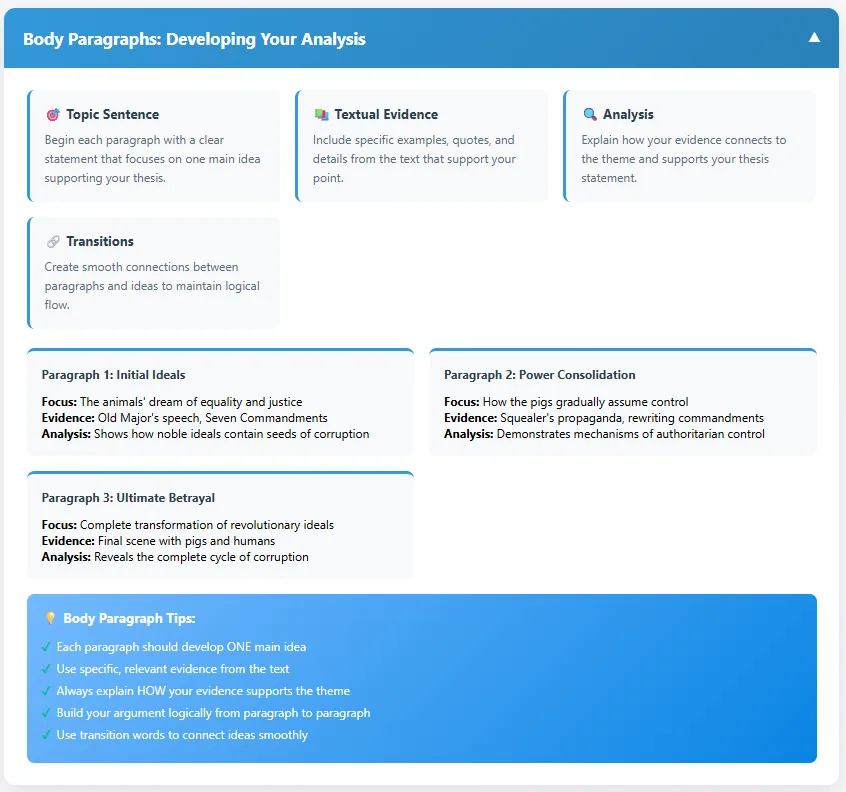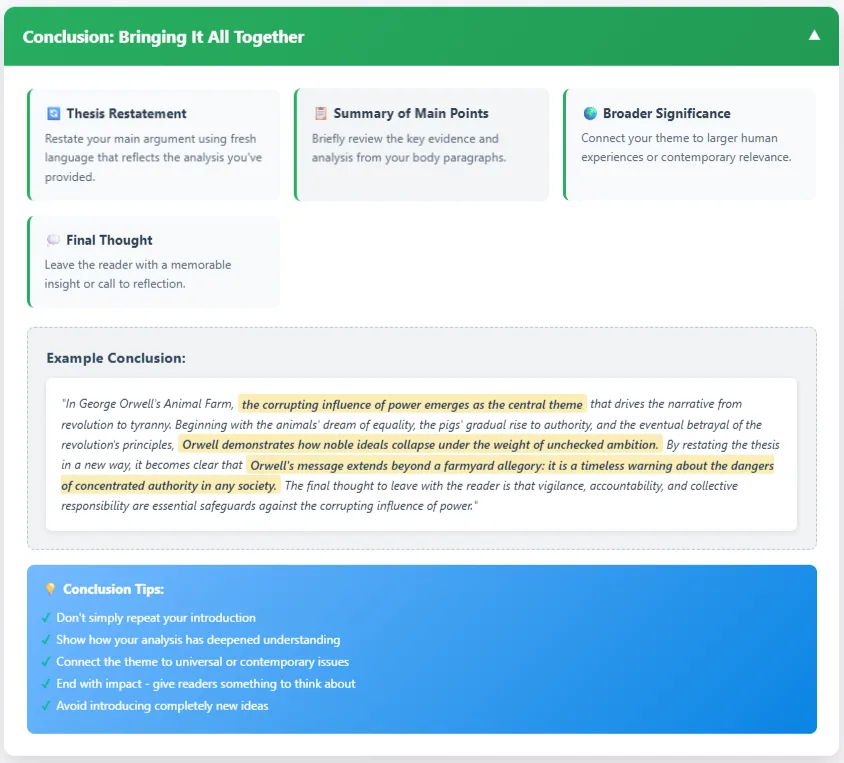What is Thematic Essay?
- Definition of a thematic essay: A thematic essay is a type of essay writing that explores a central theme, motif, or main idea within a piece of literature, historical event, or complex topic. Thematic essay writing emphasizes analysis rather than narration, requiring the essay writer to focus on a specific theme and provide evidence that supports the thesis.
- Purpose and deeper understanding: Thematic essay writing helps readers gain a deeper understanding of literature or history by analyzing how themes connect to human experiences, social structures, or corrupting influences of power. Writing a good thematic essay means the writer goes beyond the surface to craft an essay that reveals deeper meaning.
- Key elements of thematic essay structure: A thematic essay must have an introduction, body paragraphs, and a conclusion. Each paragraph should focus on one main point, supported by examples to support your thesis. This structure helps you structure your essay clearly for the reader.
- Examples of thematic essays: A thematic essay example might explore how The Hunger Games portrays the corrupting influence of power, or how a historical event illustrates resilience in the face of injustice. Each thematic essay example provides a guide to writing by demonstrating how to connect evidence and analysis essay techniques.
- Importance of thesis statement: A strong thesis statement is central to thematic essay writing. The thesis introduces the theme, outlines the main points you will discuss, and guides the reader through the thematic essay format.
How to Write a Thematic Essay in 6 Steps
Step 1: Choosing a Theme
- Start a thematic essay with clarity: Introduce the theme you’re exploring and provide background information.
- Choosing a theme: Select from thematic essay topics that allow you to analyse complex issues, such as the corrupting influence of power or resilience in historical events.
- Insightful approach: Introduce the theme in a way that hooks the reader and helps them understand why this theme matters.

Step 2: Crafting a Strong Thesis Statement
- Present your thesis statement: State your main point clearly in the introduction.
- Structure your essay: Ensure the thesis connects with the thematic essay outline and guides the essay writing process.
- Example: In a thematic essay on The Hunger Games, the thesis could explore how the Capitol’s corrupting influence of power undermines freedom.
- Check for clarity: Ensure your thesis is focused, insightful, and strong.
Step 3: Writing the Thematic Essay Introduction
- Grab the reader’s attention: Use a hook to make the reader curious.
- Introduce the theme: Provide background information to help the reader understand the context.
- Present your thesis statement: Place it at the end of the introduction.
- Example of a thematic essay introduction: “Throughout history, literature has explored the corrupting influence of power. In The Hunger Games, this theme shows how absolute control strips individuals of freedom.”
Step 4: Developing Body Paragraphs
- Body paragraphs structure: Each paragraph should focus on one main point that supports your thesis.
- Topic sentence: Begin with a clear sentence introducing the paragraph’s focus.
- Support your analysis: Use a piece of literature, essay example, or historical event as evidence that supports your thesis.
- Analysis of the data: Go beyond summary; analyse how the theme reveals a deeper meaning.
- Use examples to support: Include a sample thematic essay reference or motif to strengthen your analysis essay.
Step 5: Reviewing the Thematic Essay Structure
- Structuring a thematic essay: Ensure logical flow from introduction, body paragraphs, to conclusion.
- Outline the main points: Organize ideas to help you structure your essay effectively.
- Support your thesis: Make sure every paragraph connects to the main thesis statement.
- Tips for writing: Use a thematic essay format with clear transitions to guide readers.
Step 6: Writing the Conclusion
- Restate your thesis: Present your thesis statement in a new way to reinforce it.
- Summarize your main points: Briefly highlight the main points and restate their significance.
- Provide a final thought: Offer an insightful comment that gives the reader a deeper understanding of the theme.
- Revising and editing: Always review for clarity, coherence, and accuracy. Ensure the rubric expectations are met, and check for clarity in every sentence.
- Example: In concluding a thematic essay on The Hunger Games, you could restate your thesis in a new way and reflect on how the narrative gives a deeper meaning to themes of survival and power.
Essay Services
Expert support for every stage of essay.
- Assistance with topic selection
- Step-by-step essay writing help
- Editing, proofreading, and formatting help
Free Consultation
Talk to our essay experts before you begin.
- One-on-one discussion of your essay
- Guidance on essay structure and citations
- Tailored advice to your course guidelines
- For persuasive writing guidance, review our collection of argumentative essay examples that demonstrate strong debate structures.
- If you’re searching for ideas to argue effectively, explore our engaging list of argumentative essay topics.
Key Checklist for a Thematic Essay
- Clear introduction
- Always begin your thematic essay with a strong introduction.
- The introduction should provide necessary background information and clearly present the central idea or theme you’re exploring.
- A clear introduction sets the tone and makes the type of writing easy to follow.
- Identify the central idea or theme
- Every thematic essay explores a central idea that relates to your theme.
- Make sure to highlight recurring ideas that will guide your analysis.
- Body paragraph should focus on one idea
- Each body paragraph should focus on a main point that directly relates to your theme.
- Use evidence from the text to support your arguments.
- Structure your essay and ensure clarity by sticking to one idea per paragraph.
- Support with text
- Writing thematic essays requires that you use evidence from the text.
- Select examples that clearly support your thesis and show how the theme resonates.
- Strong conclusion
- Restate your thesis in a new way to emphasize the main point.
- End with a closing thought or thought-provoking question that encourages the reader to reflect.
- Readers who want to inform clearly can benefit from our detailed expository essay examples.
- Not sure what to explain? Check out our complete list of expository essay topics for inspiration.
Best Practice in Developing Thematic Essay Topic
- Choose the right theme
- Select a theme that resonates with readers and is easy to analyze.
- A theme that resonates makes it easier to craft strong analysis.
- Outline will help
- An outline will help structure your essay and ensure every section flows logically.
- It also keeps the essay easy to follow from introduction to conclusion.
- Start writing with clarity
- Before you start writing, decide whether the essay might explore themes such as the corrupting influence of power or recurring ideas in literature.
- Ensure the body paragraph should focus on evidence that relates to your theme.
- Balance text and analysis
- Always use evidence from the text alongside your analysis.
- This balance shows how your points and restate your thesis effectively.
- Ask guiding questions
- Use a thought-provoking question to refine your thematic essay topic.
- This guides both your writing thematic approach and the reader’s interpretation.
- If your focus is on vivid imagery, our descriptive essay examples will show you how to capture detail effectively.
- Looking for creative subjects to describe? Browse our wide selection of descriptive essay topics.
Top 40 Examples of Thematic Essay Topics
When you start writing a thematic essay, it is important to choose the right theme that resonates and explores a central idea. Below is a list of 40 thematic essay topics grouped into literature, history, and broader themes. Each one allows you to structure your essay and ensure you can use evidence from the text while crafting an analysis that is easy to follow.
Literature-Based Thematic Essay Topics
- The corrupting influence of power in Macbeth.
- Recurring ideas of survival in The Hunger Games.
- The central idea of love in Pride and Prejudice.
- Friendship and loyalty in Of Mice and Men.
- The theme of justice in To Kill a Mockingbird.
- Identity and belonging in The Catcher in the Rye.
- Corrupting ambition in Frankenstein.
- The recurring motif of fate in Oedipus Rex.
- Exploring oppression in The Handmaid’s Tale.
- The deeper meaning of courage in The Lord of the Rings.
History-Based Thematic Essay Topics
- The fight for civil rights in the 1960s.
- The recurring idea of freedom in the American Revolution.
- The corrupting influence of power in totalitarian regimes.
- The central idea of resilience in the Great Depression.
- The theme of justice in the Nuremberg Trials.
- The recurring ideas of equality in the Women’s Suffrage Movement.
- The role of nationalism in World War I.
- The deeper meaning of resistance in anti-apartheid struggles.
- Corruption and reform during the Progressive Era.
- The recurring idea of democracy in the fall of the Berlin Wall.
Society and Culture Thematic Essay Topics
- The impact of technology on identity and belonging.
- The corrupting influence of social media power.
- Recurring ideas of environmental justice in modern society.
- The central idea of cultural diversity in globalization.
- The recurring theme of migration and identity.
- Gender equality and its deeper meaning in education.
- The impact of poverty as a recurring idea in developing nations.
- Exploring recurring ideas of freedom of speech.
- The central theme of healthcare justice.
- The corrupting influence of wealth in modern politics.
Philosophy and Ethics Thematic Essay Topics
- The deeper meaning of morality in decision-making.
- The recurring theme of human rights across nations.
- The corrupting influence of unchecked ambition.
- Exploring recurring ideas of truth and lies in society.
- The theme of justice in ethical debates on AI.
- The central idea of personal responsibility in climate change.
- Recurring ideas of power and inequality in philosophy.
- The theme that resonates in debates about free will.
- Exploring recurring ideas of duty and honor in ethics.
- The central idea of happiness in human life.
Thematic Essay Outline, with Examples
Introduction Section
- The introduction of a thematic essay is the reader’s first encounter with your analysis. Its role is to introduce the theme, provide necessary background information, and most importantly, present a strong thesis statement.
- A well-developed introduction should also include a hook that captures the reader’s interest, such as a striking quote, a provocative question, or a concise overview of the theme in context.
- In the case of a thematic essay on Orwell’s Animal Farm, the theme is the corrupting influence of power.
- The introduction should outline how the novel explores this central idea through recurring motifs, historical parallels to the Russian Revolution, and the transformation of the animals’ original ideals into oppressive authoritarianism.

Example of a strong introduction:
“Throughout history, literature has revealed the dangers of unchecked ambition and authority. George Orwell’s Animal Farm stands as a striking thematic essay example of how power, when concentrated in the hands of the few, corrupts ideals and undermines collective freedom. This thematic essay explores the central idea that absolute authority, though often justified as necessary for order and progress, leads to tyranny and oppression. Through the rise of the pigs, Orwell illustrates the corrupting influence of power, exposing how noble principles become twisted when leaders seek control above all else. This analysis will show how the novel’s recurring ideas of inequality, propaganda, and betrayal support the thesis that unchecked authority inevitably erodes the very foundations of justice and equality.”
This introduction is effective because it:
- Provides necessary background information (literary context, historical parallel).
- Clearly identifies the central idea or theme (corrupting influence of power).
- Ends with a thesis statement that outlines the direction of the essay.
Body Paragraphs
- The body paragraphs of a thematic essay develop the main points of the thesis in detail.
- Each paragraph should begin with a topic sentence that focuses on one idea, followed by evidence from the text and analytical commentary that connects the evidence to the theme.
- In addition, transitions between paragraphs ensure the thematic essay is easy to follow and that the structure is logical.
In our example on Animal Farm, the essay can be structured around three main points:
- The initial ideals of equality and justice.
- The gradual consolidation of power by the pigs.
- The final betrayal of the revolution’s principles.

Example Body Paragraph 1 (Ideals of Equality):
“At the beginning of Animal Farm, Orwell introduces the animals’ dream of a society built on equality and justice. Old Major’s speech outlines the central idea of freedom from oppression, inspiring the animals to envision a world where all members share labor and rewards equally. This vision reflects a recurring idea in history: revolutions often start with noble ideals. In this thematic essay example, the body paragraph should focus on how these ideals function as both motivation and illusion. The animals’ adoption of the Seven Commandments represents an attempt to structure society fairly. However, by analysing this moment closely, one sees that the seeds of corruption are already present, as the pigs assume leadership roles and claim privileges, subtly undermining the collective vision. Orwell suggests that even at the outset, the corrupting influence of power is beginning to erode the revolutionary dream.”
Example Body Paragraph 2 (Consolidation of Power):
“As the narrative progresses, Orwell illustrates how power consolidates in the hands of the pigs, particularly Napoleon. This body paragraph should focus on the mechanisms of control—propaganda, fear, and violence—that ensure obedience. Squealer’s manipulation of language provides evidence from the text of how propaganda distorts truth and reshapes reality. The recurring idea of rewriting history—such as altering the commandments—shows how the pigs transform ideals into tools of domination. Analysing these details reveals that the central idea of power is not neutral but inherently corrupt when unchecked. The thematic essay here demonstrates that the corrupting influence of power thrives when authority goes unquestioned, leading to systematic inequality that contradicts the original vision.”
Example Body Paragraph 3 (Betrayal of Principles):
“By the conclusion of Animal Farm, Orwell presents the ultimate betrayal of revolutionary ideals: the pigs become indistinguishable from the humans they once opposed. The final scene, in which the animals can no longer tell pigs from men, serves as powerful text to support the theme. This body paragraph should focus on how the corrupting influence of power completes its cycle. The recurring motif of inequality reaches its peak as the pigs enjoy privileges while the other animals suffer. By analysing this transformation, the thematic essay exposes the irony that the revolution, intended to bring freedom, results in greater oppression. The betrayal underscores Orwell’s warning that without accountability, leaders exploit power for self-interest, leaving the collective dream shattered.”
These body paragraphs are effective because they:
- Begin with clear topic sentences that relate directly to the thesis.
- Use evidence from the text to support the analysis.
- Show how each main point relates to the central idea or theme.
- Maintain an easy to follow structure, building logically toward the conclusion.
Conclusion Section
- The conclusion of a thematic essay must do more than simply summarize.
- It should restate the thesis in a new way, briefly review the main points, and offer a closing thought that leaves the reader with deeper understanding.
- The conclusion is also the place to highlight the broader significance of the theme, showing how it resonates beyond the text itself.

Example of a strong conclusion:
“In George Orwell’s Animal Farm, the corrupting influence of power emerges as the central theme that drives the narrative from revolution to tyranny. Beginning with the animals’ dream of equality, the pigs’ gradual rise to authority, and the eventual betrayal of the revolution’s principles, Orwell demonstrates how noble ideals collapse under the weight of unchecked ambition. This thematic essay has shown, through recurring ideas of propaganda, inequality, and betrayal, how power inevitably distorts justice and truth. By restating the thesis in a new way, it becomes clear that Orwell’s message extends beyond a farmyard allegory: it is a timeless warning about the dangers of concentrated authority in any society. The final thought to leave with the reader is that vigilance, accountability, and collective responsibility are essential safeguards against the corrupting influence of power, making Orwell’s cautionary tale as relevant today as it was at its publication.”
This conclusion works well because it:
- Restates the thesis without repeating it word-for-word.
- Summarizes the main points of the body paragraphs.
- Ends with a thought-provoking closing thought that connects the theme to a broader context.
Final Thoughts on Key Tips for Writing a Thematic Essay
- Start with clarity – Always begin with a clear introduction that introduces the central idea or theme.
- Craft a strong thesis – Present your thesis statement early to guide your essay.
- Use evidence from the text – Support your analysis with examples that relate to your theme.
- Structure your essay and ensure flow – Each body paragraph should focus on one idea.
- Restate your thesis in a new way – Conclude by summarizing main points and ending with a closing thought that leaves deeper understanding.
Sources
- How to Write a Thematic Essay: Guide and Examples. Available at: https://kaitlynessays.com/how-to-write-a-thematic-essay-guide-and-examples/
- Theme Analysis Idea Development – A Writer’s Handbook. Available at: https://library.jeffersonstate.edu/c.php?g=798707&p=5721955
- Thematic Development in Students’ Argumentative Essay. Available at: https://www.researchgate.net/publication/364215587_Thematic_Development_in_Students’_Argumentative_Essay
- For expert help in crafting a high-quality thematic essay or any academic paper, trust Best Dissertation Writers to guide you from start to finish,
- For storytelling inspiration, explore our narrative essay examples that illustrate how personal experiences can be crafted into essays.
- Need story ideas? Discover our list of narrative essay topics to spark your creativity.
What People Also Ask About Thematic Essay
-
What is an example of thematic writing?
An example of thematic writing can be seen in a thematic essay that explores the corrupting influence of power in George Orwell’s Animal Farm. The essay focuses on how recurring motifs, such as propaganda and betrayal, develop the central idea. Instead of retelling the story, thematic writing requires analyzing evidence from the text to show how it supports a universal theme. This makes the writing more insightful and helps readers understand broader truths about society.
-
What does a thematic essay look like?
A thematic essay looks like a structured academic paper with three main parts: an introduction, body paragraphs, and a conclusion. The introduction identifies the central theme and presents a thesis statement. Each body paragraph should focus on one idea, supported with evidence from the text, while the conclusion restates the thesis in a new way. For example, a thematic essay on justice in To Kill a Mockingbird analyzes characters and events to reveal the deeper meaning of equality.
-
What is the thematic way of writing?
The thematic way of writing emphasizes analysis rather than summary. In a thematic essay, you’re exploring the theme by analyzing how recurring ideas, motifs, or character actions reflect a central message. This type of writing requires careful analysis of the evidence, showing how it supports the thesis. For instance, a thematic essay on resilience during the Great Depression might explore speeches, stories, or historical accounts that highlight endurance. This approach helps readers see deeper connections beyond surface-level details.
-
How do you write a thematic statement?
To write a thematic statement, you first identify the central theme in the text. In a thematic essay, this involves condensing the lesson or universal truth into a clear, concise sentence. A thematic statement avoids specifics about characters and instead focuses on what the story reveals about life or society. For example, from Shakespeare’s Macbeth, a strong thematic statement could be: “Unchecked ambition leads to corruption.” This guides the essay by shaping the thesis and supporting analysis.
